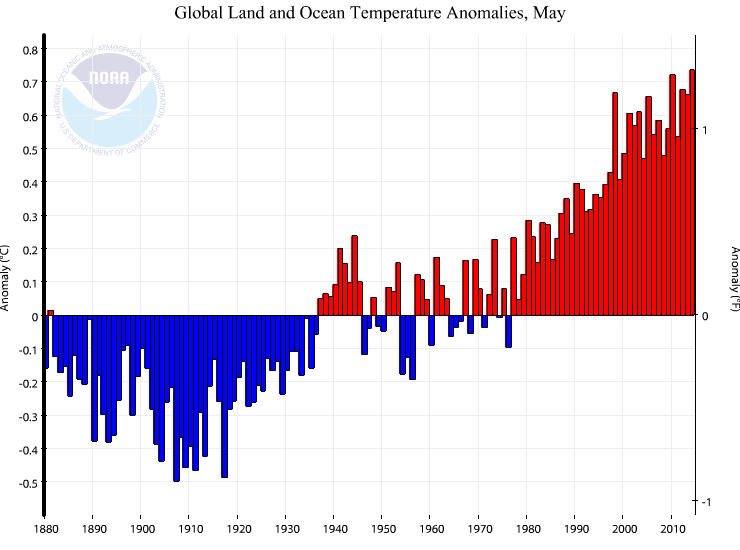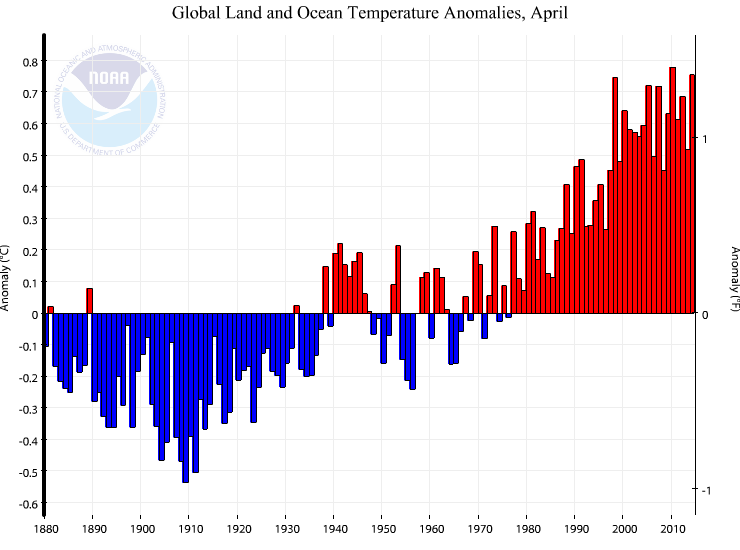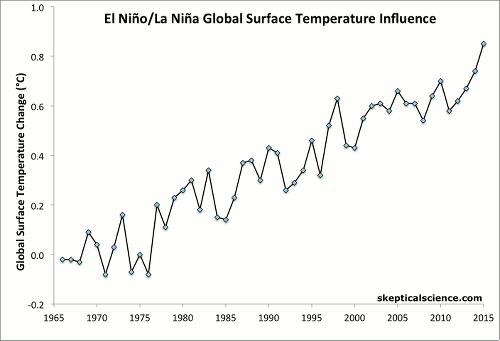
Increasing greenhouse gases in the atmosphere, from human industrial activity, are trapping ever more heat in the atmosphere and ocean. This is causing the Earth to warm regardless of a downturn in solar radiation over the last 3-4 decades. Despite this long-term warming of the background climate state, especially the warming of the ocean, global surface temperatures exhibit fluctuations from year-to-year because the Earth's weather is never the same in each year.

Figure 1 - global surface temperature anomalies for the month of May since 1880. 2014 is, globally, the warmest May in 135 years of observation. Image from NOAA NCDC.
Typically, the largest year-to-year variations in global surface temperature are due to natural variations in the way that the ocean and atmospheric circulations interact with each other, because this affects the manner in which heat is stored in the oceans, and the amount, and distribution, of cloud cover too. What I'm referring to here is the coupled ocean-atmosphere phenomenon known as the El Niño-Southern Oscillation, or ENSO. One extreme of ENSO, La Niña, acts to cool surface temperatures over the Earth because of increased subsurface storage of heat in the ocean, and the other extreme, El Niño, acts to raise surface temperatures due to a discharge of anomalous tropical ocean heat to the atmosphere.

Figure 2 - global surface temperature anomalies for the month of April since 1880. April 2014 is, globally, the 2nd warmest April (tied with 1998, and behind 2010) in 135 years of observation. Image from NOAA NCDC.
In 2014 the climate system has aggressively moved toward El Niño development, although official declaration of El Niño requires three months of tropical sea surface temperatures above a defined threshold. Nevertheless, the discharge of heat from the tropical ocean is already beginning to have an effect on global surface temperatures with April 2014 being the 2nd warmest in 135 years of measurement (tied with 1998), and May 2014 the warmest ever in 135 years. These records might not last very long, if past El Niño trends are a reliable indicator, as the tail end of strong El Niños in the following year often sees the April & May records tumble.
2014 is currently on track to be one of the warmest years ever recorded, perhaps even the warmest. This will depend on how, or if, El Niño develops throughout the rest of the year. Recent observations suggest, however, that 2010's reign as the warmest year on record is seriously under threat.
 Figure 3 - Global surface temperature data from Cowtan & Way, separated into El Niño (red), La Niña (blue), and Neutral (black) years for 1966–2013, with linear trends plotted for each category.
Figure 3 - Global surface temperature data from Cowtan & Way, separated into El Niño (red), La Niña (blue), and Neutral (black) years for 1966–2013, with linear trends plotted for each category.
Posted by Rob Painting on Tuesday, 1 July, 2014
 |
The Skeptical Science website by Skeptical Science is licensed under a Creative Commons Attribution 3.0 Unported License. |